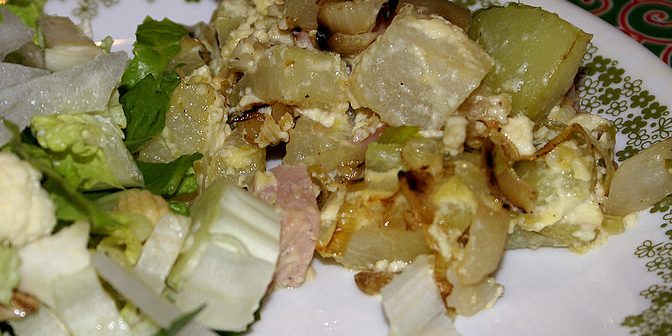…and what do you do with it?
That’s a question I’ve been asked many times at the grocery store check out stand from either customers or the clerk when I’ve bought a couple of unusual vegetables. While not uncommon or even unknown in the United States, they are odd-looking and often overlooked by shoppers. I am speaking of kohlrabi and celery root, two very delicious vegetables that can add a different flair to your dinner while coming in at a lower calorie and carbohydrate count than a potato, pasta, or rice.
So, I’m on a mission to introduce more people to these tasty but lesser known edibles.
To be honest, I didn’t discover them until the past few years when I started changing over to a low carb lifestyle to manage my weight. A friend in Europe told me about kohlrabi and while picking one up at the store, I was curious about celery root. Both vegetables are peculiar-looking, but the flavor they hide is wonderful.

Kohlrabi is a cousin of broccoli and if you like the taste of that vegetable’s stem, then imagine it in a milder version and you have the taste of kohlrabi. It looks like an alien plant when you see it with the leaves attached as the stems come out from all over the round vegetable. The leaves are also good to cook and eat along with other greens.
Most often, it seems people who use kohlrabi grate or chop it to add to salads. However, it is wonderful when cooked. I make kohlrabi fries just as I would potato ones. You can also boil it into a mash with other vegetables, steam it, roast it, or turn it into a scalloped dish. It works best for these dishes when precooked a little to speed up the cooking time. You can also par-boil and freeze it.

Now, celery root looks like a big, ugly lump when you see it in the store. It’s a gnarly-looking root. This is not your usual garden celery, but the celeriac root. The taste of it has a hint of celery, but it isn’t very strong. Once you peel off the exterior and clean it up, the meat is versatile. You can use it almost any way you use a potato. In fact, if you wash it up well, cut it in half and bake it, it makes a great substitute for a baked potato. Just don’t eat the skin.Texture-wise, it’s the only substitute vegetable I’ve found, apart from other potato family ones, that is like a potato when baked. It makes fabulous plank fries and goes well in soups.
I’ve also added turnips to my meal plans, finding that turnips and cauliflower mashed together with butter and cream made a great-tasting substitute for mashed potatoes. Cauliflower flowerets along with diced turnips, kohlrabi, or celery root can make a great-tasting macaroni-free cheese dish.
Apart from changing up the usual starches at dinner, these options are also lower in calories and carbs. If you’re wanting to cut back a little, try one of these vegetables for a change.
Take a look at the differences in nutrition:
Kohlrabi – per 1/2 cup:
18 calories 4.2 grams carbohydrates 2.5 g fiber 1.2 g protein
Celery root – per 1/2 cup
33 calories 7.2 g carbohydrates 1.3 fiber 1.2 protein
Turnips – per 1/2 cup
18.2 calories 4.2 g carbohydrates 1.2 g fiber 0.6 gr protein
Potatoes – per 1/2 cup:
51.8 calories, 11.8 g carbohydrates 1.8 g fiber 1.3 g protein
Have you tried kohlrabi or celery root? If so, how did you use them and what did you think?
Pictured at the top is a Broccoli, kohlrabi and ham bake. All photos are copyright by the author.

